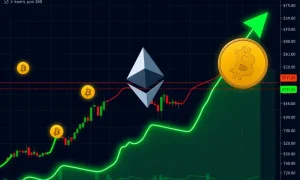Excitement is building within the cryptocurrency market as Bitcoin (BTC) traders set ambitious price targets. Many now eye the **Bitcoin price** reaching as high as $137,000. This bullish sentiment follows the latest US Consumer Price Index (CPI) report, which significantly increased the likelihood of a Federal Reserve interest rate cut. Market participants are now pricing in a remarkable 94% chance of monetary easing, creating a potentially fertile ground for risk-on assets like Bitcoin.
Understanding the CPI Impact on Bitcoin Price
The July US Consumer Price Index (CPI) report recently captured market attention. It showed inflation holding steady at 2.7% year-over-year. This figure remained unchanged from June’s reading and came in below the anticipated 2.8%. Furthermore, core CPI, which excludes volatile food and energy prices, increased 3.1% annually, aligning with expectations. On a monthly basis, overall CPI saw a modest 0.2% increase, easing from 0.3% in June. Core CPI also rose by 0.3%, compared to a 0.2% gain previously.
This data provides a mildly bullish backdrop for the **Bitcoin price**. Why? Cooling inflation strengthens the argument for the Federal Reserve to implement monetary easing. A lower interest rate environment generally reduces the opportunity cost of holding non-yield-bearing assets like Bitcoin. Consequently, this scenario could attract fresh capital into the cryptocurrency market. Investors often seek higher returns in riskier assets when traditional savings offer less.
Historically, periods of quantitative easing or lower interest rates have often correlated with increased liquidity in financial markets. This liquidity can then flow into assets perceived as growth opportunities, including cryptocurrencies. Therefore, the latest CPI figures are being closely watched by those analyzing the future trajectory of the **Bitcoin price**.
The Federal Reserve’s Stance and Rate Cut Odds
Following the encouraging CPI data release, market expectations for a September Fed rate cut surged dramatically. According to the CME FedWatch Tool, the probability of a rate cut now stands at an impressive 93.9%. Traders are clearly pricing in a higher likelihood of monetary easing. This significant shift reflects growing confidence that the Fed might soon pivot from its hawkish stance.
[Image: US interest rate cut possibility for Sept. 17. Source: CME FedWatch]
However, the in-line core CPI figure suggests that underlying price pressures may still persist. This indicates the Fed might require more evidence before taking decisive action. The central bank typically seeks sustained signs of inflation moving towards its 2% target before adjusting policy. Nevertheless, the overwhelming market sentiment points towards a rate cut as the most probable outcome. A rate cut would likely reduce borrowing costs across the economy. This could stimulate economic activity and potentially boost investment in growth-oriented sectors, including digital assets. Many believe this could provide a substantial tailwind for the **Bitcoin price**.
Looking ahead, next week’s Producer Price Index (PPI), estimated at 2.3%, and Core PPI, estimated at 2.5%, will be crucial. A softer-than-expected print from these indicators could further confirm a bullish macro setup for Bitcoin. Such a development would reinforce lower rate expectations and boost demand for risk assets like Bitcoin. Conversely, higher-than-expected PPI figures might temper enthusiasm for immediate rate cuts, potentially introducing short-term volatility for the **Bitcoin price**.
Bitcoin Price Targets and Technical Breakouts
Bitcoin experienced a bullish weekend, surging to Monday highs of $122,190. However, these gains were short-lived, as the price quickly dipped 3% to $118,500. It notably failed to secure a daily close above the critical $120,000 mark. Post-US CPI release, BTC rebounded to $119,500. A decisive close above $119,982 remains key to confirming immediate upside momentum. Achieving a daily close above $120,000 would be a historic first, potentially igniting the next leg of Bitcoin’s rally. This psychological barrier holds significant weight for traders.
On the technical front, a bullish flag pattern on the daily chart recently broke to the upside. This pattern typically signals a continuation of the preceding uptrend. The current pullback could represent a retest of the breakout level before continuation towards the primary target of $130,000. This technical formation provides a strong visual indicator for many market participants. Analysts often use such patterns to project future price movements. Furthermore, the volume accompanying these moves can confirm the strength of the breakout.
[Image: Bitcoin one-day analysis. Source: StockPil/TradingView]
Notably, technical analyst Titan of Crypto projects a similar bullish scenario. They eye a **Bitcoin price** of $137,000 based on a descending trendline breakout observed on Sunday. This specific target highlights the confluence of various technical indicators pointing towards significant upside potential. Traders often combine multiple technical signals to increase their conviction in a particular price direction. These include moving averages, Relative Strength Index (RSI), and MACD. The current technical setup appears robust, suggesting strong buying interest at key levels.
However, failure to reclaim and hold above $120,000 could invite short-term downside pressure. This level acts as a pivotal point for current market sentiment. A sustained rejection could lead to profit-taking and a re-evaluation of bullish positions. Therefore, monitoring this price point closely is essential for traders. The battle between bulls and bears often centers around such significant psychological and technical levels. The **Bitcoin price** movement around this area will dictate its immediate future direction.
Key Support Levels and Potential Downside for Bitcoin
Immediate support for the **Bitcoin price** lies in the $117,650–$115,650 zone. This area represents a crucial technical floor where buying interest is expected to emerge. This key support area also coincides with a CME gap formed over the weekend. CME gaps occur when the closing price of Friday’s futures contract differs significantly from Monday’s opening price. Many traders believe these gaps tend to fill over time, making this zone particularly important to watch. A bounce from this region would reinforce the bullish outlook.
[Image: Bitcoin four-hour analysis. Source: StockPil/TradingView]
As noted by StockPil, despite holding higher ground, BTC is not entirely immune to losing the critical $100,000 support level. A deeper correction could potentially test levels as low as $95,000. This scenario would involve a significant capitulation event, often triggered by unexpected negative news or a broad market downturn. The $95,000 mark is also notable as it aligns with another CME gap, a larger one that has remained unfilled for some time. Traders often view unfilled CME gaps as potential price magnets. Therefore, while the current outlook is optimistic, market participants must remain vigilant. Understanding these support levels helps in managing risk. It also allows for strategic entry or exit points. The volatility inherent in cryptocurrency markets necessitates a cautious approach, even amidst strong bullish signals for the **Bitcoin price**.
Broader Market Implications and Future Outlook for Bitcoin
The macroeconomic landscape plays a significant role in influencing the **Bitcoin price**. The narrative of cooling inflation and potential rate cuts extends beyond just the crypto market. It impacts global financial markets. Lower interest rates generally make equities and other risk assets more attractive by reducing the discount rate applied to future earnings. This broader positive sentiment can create a favorable environment for Bitcoin, which often acts as a high-beta asset, meaning it tends to amplify movements in the broader market.
Furthermore, the increasing institutional adoption of Bitcoin continues to be a driving force. Large financial institutions and corporations are showing greater interest in allocating capital to digital assets. This trend provides underlying support for the **Bitcoin price**. Regulatory clarity, though still evolving, also contributes to this growing confidence. As more structured investment products become available, the barrier to entry for traditional investors lowers. This could lead to a steady influx of capital into the Bitcoin ecosystem. The long-term outlook remains positive for many analysts, provided these fundamental drivers continue to strengthen.
The interplay between traditional finance and the crypto world is becoming more intertwined. Macroeconomic data points, such as CPI and PPI, now routinely influence cryptocurrency trading strategies. This signifies Bitcoin’s maturation as an asset class. Its correlation with traditional risk assets has grown, making it more susceptible to global economic shifts. Therefore, staying informed about broader economic indicators is crucial for anyone monitoring the **Bitcoin price**.
Ultimately, the current market dynamics present a compelling case for a continued rally in the **Bitcoin price**. The confluence of easing inflation pressures, high probabilities of Fed rate cuts, and positive technical indicators paints an optimistic picture. While potential downside risks always exist, particularly around key support levels, the prevailing sentiment is strongly bullish. Traders are strategically positioning themselves to capitalize on these anticipated movements. The journey towards new all-time highs for Bitcoin appears increasingly plausible, underpinned by a shifting macroeconomic tide.
Frequently Asked Questions (FAQs) About Bitcoin Price and Market Trends
Q1: How does the US CPI report influence the Bitcoin price?
A1: The US CPI report measures inflation. When inflation cools, it often strengthens the case for central banks like the Federal Reserve to cut interest rates. Lower interest rates typically make non-yield-bearing assets like Bitcoin more attractive, as the opportunity cost of holding them decreases. This can lead to increased investment and a rise in the **Bitcoin price**.
Q2: What is the significance of the Federal Reserve’s potential rate cut for Bitcoin?
A2: A Federal Reserve rate cut reduces borrowing costs and injects more liquidity into the financial system. This environment generally favors risk-on assets such as Bitcoin. Investors may shift capital from lower-yielding traditional investments into assets with higher growth potential, potentially boosting the **Bitcoin price**.
Q3: What are CME gaps, and why are they important for Bitcoin traders?
A3: CME gaps occur when the Bitcoin futures market on the Chicago Mercantile Exchange (CME) closes on a Friday at a different price than it opens on Monday. Many traders believe these gaps tend to be ‘filled’ by price action eventually. They often act as potential support or resistance levels, making them key areas for traders to watch for the **Bitcoin price**.
Q4: What technical indicators are currently supporting Bitcoin’s bullish outlook?
A4: Several technical indicators support a bullish outlook. These include a recent breakout from a bullish flag pattern on the daily chart, which often signals continuation of an uptrend. Additionally, a descending trendline breakout observed by analysts like Titan of Crypto points towards higher price targets for the **Bitcoin price**.
Q5: What are the key support levels to watch for Bitcoin price?
A5: Immediate key support for Bitcoin lies in the $117,650–$115,650 range, which also coincides with a recent CME gap. A more significant support level is the $100,000 mark, with a deeper correction potentially testing levels as low as $95,000, which aligns with another notable CME gap.
Q6: How does the Producer Price Index (PPI) relate to Bitcoin’s future price?
A6: The Producer Price Index (PPI) measures inflation from the perspective of producers. A softer-than-expected PPI print would further indicate cooling inflation pressures, reinforcing the case for Fed rate cuts. This macro development could strengthen the bullish setup for Bitcoin, potentially increasing demand for the asset and influencing the **Bitcoin price** positively.








